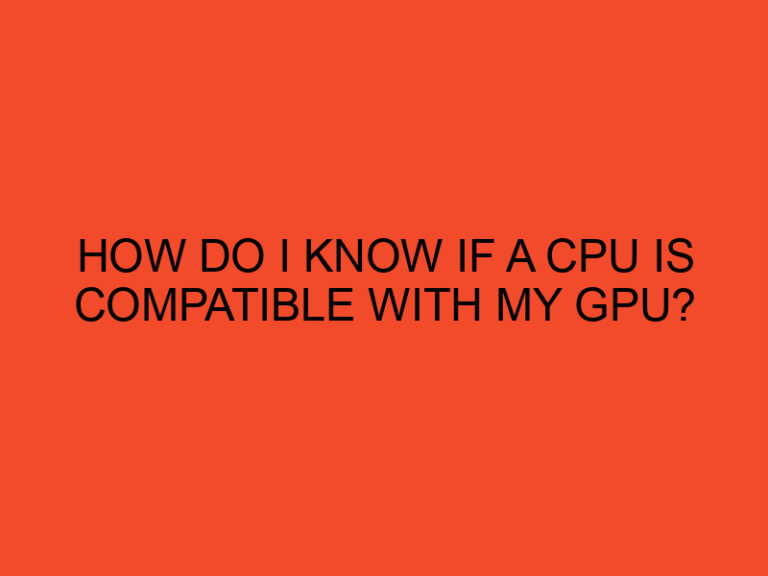When it comes to computer processors, the central processing unit (CPU) is often referred to as the brain of the computer. It performs various computations and executes instructions to carry out tasks. But have you ever wondered where the CPU stores its computations? In this article, we will explore the different types of memory used by the CPU to store and access data.
Table of Contents
CPU Architecture Overview
Before diving into the details of CPU memory storage, let’s have a brief overview of CPU architecture. The CPU consists of several components, including the arithmetic logic unit (ALU), control unit, and memory unit. The ALU performs mathematical and logical operations, while the control unit manages the execution of instructions. The memory unit is responsible for storing and retrieving data.
Primary Storage: Registers and Cache
The CPU has a hierarchy of memory storage, starting with the fastest and smallest memory units. At the top of this hierarchy are the registers and cache. Registers are tiny storage areas located within the CPU itself. They hold data and instructions that the CPU needs to access quickly. Registers have very low latency, enabling rapid data retrieval and execution.
Cache memory, on the other hand, is a small but faster memory located closer to the CPU than main memory. It acts as a buffer between the CPU and the main memory. Cache memory stores frequently accessed data and instructions, reducing the latency of accessing information from the main memory.
Secondary Storage: RAM
Moving down the memory hierarchy, we encounter random access memory (RAM). RAM is a type of volatile memory that temporarily stores data and instructions while the CPU is actively processing them. It provides fast read and write operations, making it ideal for storing the working data of running programs. RAM is an essential component of any computer system and directly affects the overall performance.
Tertiary Storage: Hard Disk Drives
While primary storage, such as registers, cache, and RAM, provides fast access to data, it is limited in capacity and loses its contents when the power is turned off. To overcome these limitations, computer systems also rely on tertiary storage devices, with hard disk drives (HDDs) being the most common.
HDDs are non-volatile storage devices that use rotating magnetic disks to store data. They offer much larger storage capacities than primary storage but at the expense of slower access speeds. Data stored on HDDs persists even when the computer is powered off, making them suitable for long-term storage.
Volatile vs. Non-Volatile Memory
As mentioned earlier, primary storage (registers, cache, and RAM) is volatile, while tertiary storage (HDDs) is non-volatile. The distinction between volatile and non-volatile memory lies in their ability to retain data without power.
Volatile memory requires a constant power supply to maintain the stored data. Once the power is cut off, the data is lost. Non-volatile memory, on the other hand, retains data even when power is not supplied. This characteristic is crucial for preserving data across power cycles and system reboots.
Virtual Memory
To address the limitations of physical memory (registers, cache, RAM), modern operating systems employ a technique called virtual memory. Virtual memory expands the available memory by using a portion of the hard disk as an extension of the RAM.
When the RAM becomes full, the operating system transfers less frequently used data from the RAM to the hard disk, making room for new data. This process is known as paging. Although virtual memory enables larger memory spaces, accessing data from the hard disk is significantly slower than accessing it from physical memory.
Memory Management Units
To facilitate the storage and retrieval of data across different types of memory, CPUs utilize memory management units (MMUs). MMUs handle the translation between virtual memory addresses used by programs and the physical addresses of the actual memory locations.
By using MMUs, the CPU can efficiently manage memory and ensure that the correct data is fetched from the appropriate memory location, regardless of its physical location.
Memory Hierarchy
The CPU’s memory hierarchy, consisting of registers, cache, RAM, and tertiary storage, provides a balance between speed, capacity, and cost. The closer a memory unit is to the CPU, the faster it is but with limited capacity. As we move away from the CPU, the memory units offer larger storage capacity but at the expense of slower access times.
Impact of Storage on Performance
The choice of memory storage can significantly impact the overall performance of a computer system. Faster memory units like registers and cache enable quicker access to data, reducing processing time. However, the limited capacity of these memory units necessitates the use of larger but slower memory units like RAM and HDDs for storing larger amounts of data.
Efficient memory management, including proper utilization of cache memory and optimization of data access patterns, plays a crucial role in maximizing performance. It ensures that frequently accessed data is readily available in faster memory units, minimizing the need to access slower storage devices.
Conclusion
In conclusion, the CPU stores its computations in a hierarchy of memory units. Registers and cache memory provide fast access to frequently used data, while RAM serves as the primary storage for working data. Tertiary storage devices like hard disk drives offer larger storage capacities but at slower access speeds. The proper management and utilization of these memory units are essential for optimizing the performance of computer systems.
FAQs
Can the CPU directly access data from a hard disk drive?
No, the CPU cannot directly access data from a hard disk drive. The data must first be transferred from the HDD to primary storage (registers, cache, or RAM) before the CPU can access it.
What happens if the power is suddenly cut off? Will the CPU lose all the computations?
The CPU’s primary storage (registers and cache) is volatile and will lose its contents when the power is cut off. However, secondary storage devices like RAM and tertiary storage devices like hard disk drives retain their data even without power.
Is virtual memory the same as physical memory?
No, virtual memory and physical memory are not the same. Physical memory refers to the actual RAM installed in a computer system, while virtual memory is an extension of the RAM created by using a portion of the hard disk.
How does cache memory improve performance?
Cache memory improves performance by storing frequently accessed data and instructions closer to the CPU. This reduces the latency of accessing information from the main memory, resulting in faster data retrieval and execution.






